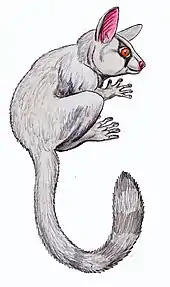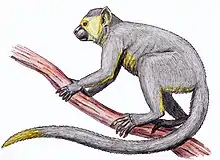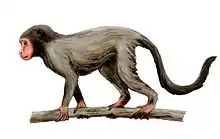| Hispaniola monkey Temporal range: Quaternary | |
|---|---|
Extinct (early 1500s) | |
| Scientific classification | |
| Domain: | Eukaryota |
| Kingdom: | Animalia |
| Phylum: | Chordata |
| Class: | Mammalia |
| Order: | Primates |
| Suborder: | Haplorhini |
| Infraorder: | Simiiformes |
| Family: | Pitheciidae |
| Subfamily: | Pitheciinae |
| Tribe: | †Xenotrichini |
| Genus: | †Antillothrix MacPhee, Horovitz, Arredondo, & Jimenez Vasquez, 1995 |
| Species: | †A. bernensis |
| Binomial name | |
| †Antillothrix bernensis Rímoli, 1977 | |
| Synonyms | |
| |
The Hispaniola monkey (Antillothrix bernensis) is an extinct primate that was endemic on the island of Hispaniola, in the present-day Dominican Republic. The species is thought to have gone extinct around the 16th century. The exact timing and cause of the extinction are unclear, but it is likely related to the settlement of Hispaniola by Europeans after 1492.
Description
Horovitz and MacPhee[1] developed the hypothesis, first proposed by MacPhee et al.,[2] that all the Antillean monkeys (the others being the two Cuban monkey species of genus Paralouatta, and the Jamaican monkey, Xenothrix mcgregori) belonged to a monophyletic group linked most closely with the modern genus Callicebus. They later assigned the Antillean monkeys to the tribe Xenotrichini[3] – the sister group of the tribe Callicebini with extensive anatomical comparisons and by extending their parsimony analysis using PAUP*.[4] They maintained that the monophyly of the Antillean monkeys was still supported in the most parsimonious trees, but in slightly less parsimonious trees, Aotus appeared to be linked with Xenothrix.
Skull discovery
In July 2009, Walter Pickel found a A. bernensis skull while diving in underwater caves. The skull was found in the La Jeringa Cave of Cotubanamá National Park. The skull, long bones and ribs were recovered by Walter Pickel and Curt Bowen in October 2009 under the supervision of the Dominican Republic and Alfred L. Rosenberger from Brooklyn College. The discovery supported the MacPhee et al. hypothesis of a monophyletic origin of the Antilles monkeys.[5] This 2009 discovery of the skull suggested that these primates were diurnal, due to their relatively smaller ocular orbits.[6]
See also
References
- ↑ Horovitz, I.; MacPhee, R.D.E. (1999). "The quaternary Cuban platyrrhine Paralouatta varonai and the origin of the Antillean monkeys". Journal of Human Evolution. 36 (1): 33–68. doi:10.1006/jhev.1998.0259. PMID 9924133.
- ↑ MacPhee, R.D.E.; et al. (1995). "A New Genus for the Extinct Hispaniolan Monkey Saimiri bernensis Rímoli, 1977, with Notes on Its Systematic Position". 3134. American Museum Novitates: 21.
{{cite journal}}: Cite journal requires|journal=(help) - ↑ MacPhee, R. D. E.; Horovitz, I. (May 14, 2004). "New craniodental remains of the quaternary Jamaican monkey Xenothrix mcgregori (Xenotrichini, Callicebinae, Pitheciidae), with a reconsideration of the Aotus hypothesis". American Museum Novitates. New York: American Museum of Natural History (3434): 1–51. doi:10.1206/0003-0082(2004)434<0001:NCROTQ>2.0.CO;2. S2CID 86051925.
- ↑ Swofford, D.L. (2002) PAUP*: phylogenetic analysis using parsimony (* and other methods) Version 4. Sinauer, Sunderland, MA
- ↑ Rosenberger, A. L.; Cooke, S. B.; Rimoli, R.; Ni, X.; Cardoso, L. (2010). "First skull of Antillothrix bernensis, an extinct relict monkey from the Dominican Republic". Proceedings of the Royal Society B: Biological Sciences. 278 (1702): 67–74. doi:10.1098/rspb.2010.1249. PMC 2992729. PMID 20659936.
- ↑ Kay, R.; Hunt, K.; Beeker, C.; Conrad, G.; Johnson, C.; Keller, J. (2010). "Preliminary notes on a newly discovered skull of the extinct monkey Antillothrix from Hispaniola and the origin of the Greater Antillean monkeys". Journal of Human Evolution. 60 (1): 124–128. doi:10.1016/j.jhevol.2010.09.003. hdl:10161/10794. PMID 21074827.



